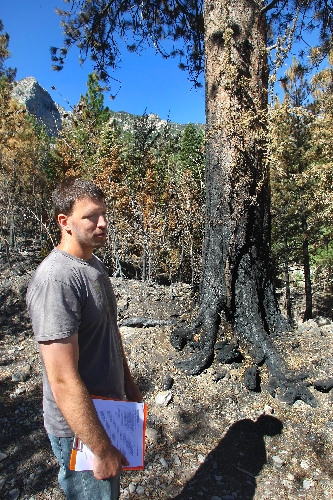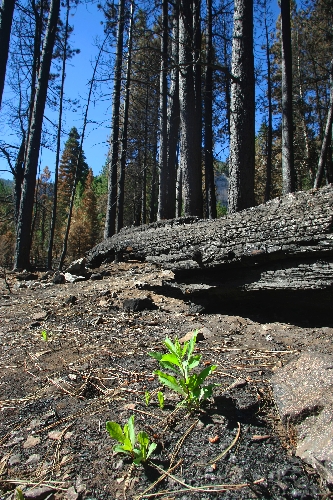Sometimes forests need fire
MOUNT CHARLESTON -- More than a month has passed since the fire, and it still smells up here.
An illegal campfire got out of control back in July. Twenty acres of mostly ponderosa pine trees burned, right behind the elementary school. Firefighters did a great job. Nobody was hurt. No houses were damaged.
But it stinks. It smells like charcoal.
Scott Abella, an ecologist at the University of Nevada, Las Vegas , says the stink probably will last a year or more.
After that, who knows. It'll probably be decades before this small patch of forest looks like it's supposed to.
It takes an average of more than 70 years for burned areas to recover, Abella's research has shown.
And the worst part?
It's largely our fault.
It has taken us 100 years to learn that we cannot control nature.
To save the forests, Abella says, we have to stop trying so hard to save the forests.
"We just have so much fuel it can ladder up into the canopy, and that kills the trees," he says.
Abella, an assistant research professor, walks around the burned area, pointing out how the largest trees, which are 100, 200, even 300 years old, are dying now. Their bark is scorched, their branches burned, their pine needles brown.
There is so much fuel on the ground, so much small growth, so much medium-sized growth, that when it all goes up in flames, the fire burns very hot and damages the roots. It also gets high enough to burn into the tops of the large trees.
That's bad for firefighters because those fires are very hard to stop.
But it's also bad for the forest. The oldest and largest trees get killed.
It didn't used to be this way. It used to be, a fire would get started -- whether by human negligence or by nature, maybe lightning -- and it would burn through the underbrush, maybe score the bark on the big trees, and go away.
That was pretty much it.
You can see evidence of that process here still. Every now and then, you'll find a huge tree, one that's a couple of centuries old, with what fire experts call a fire scar at the bottom. It's been scarred by flames, but not hurt badly enough to kill it. It happened over and over again to some of the trees.
But now? A hundred years after we decided that forest fires were always bad and so we had to do whatever it took to stop them as fast as we could?
Now, when they do happen, they get out of control.
Abella estimates an area like the one that burned in July has "missed" about 20 fires in the last 100 years. Fire is natural. It's supposed to happen. When we stop it, that allows small trees and bushes to grow.
Sometimes they keep growing when, in the past, fires would have killed them.
Some of these species aren't supposed to be here. Fire would have kept them away. But now they thrive.
Pine needles fall, too, and they don't get burned away, creating a soft, squishy carpet on the forest floor.
As Abella keeps hiking, he runs across a divide of sorts. He stands on a path.
On his left, the forest is thick and tangled. The trees are packed in so tightly you couldn't walk through there without a machete. This is what a lot of the rest of the forest looks like.
On his right, though, is an aberration. A small patch of forest is different. It is mostly large trees, so big two men couldn't wrap their arms around them. The undergrowth is slight. This is what the rest of the forest used to look like.
It is what Abella says we should try to make all the forest look like now.
People live here, though, so it would be irresponsible and ridiculous to stop fighting fires.
Thinning is the answer, Abella says. There is some debate about how to go about it, but many in the industry agree that forests need to be thinned. Studies from universities across the nation have reached the same conclusion.
That's goal number one, to make the forests more resilient. It is achievable.
But goal number two, to help the burned areas recover? That's more difficult.
Abella says there is no solid answer yet. They could plant seeds, fertilize, lay down mulch.
Or they could get out of the way and let nature take over.
Contact reporter Richard Lake at rlake@reviewjournal.com or 702-383-0307.


















